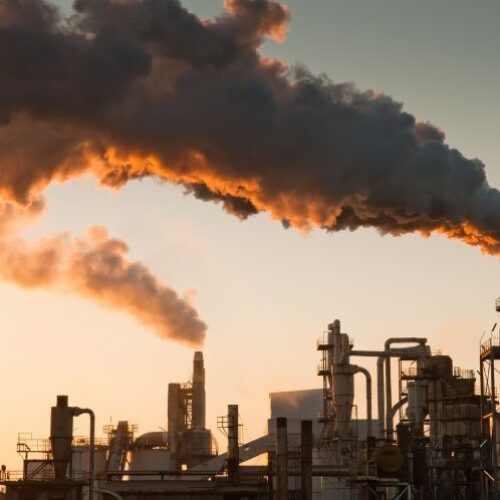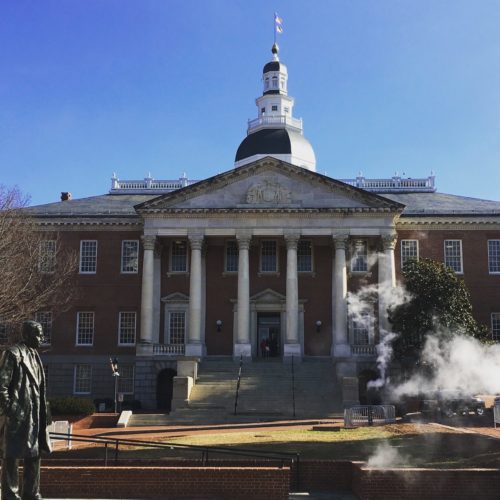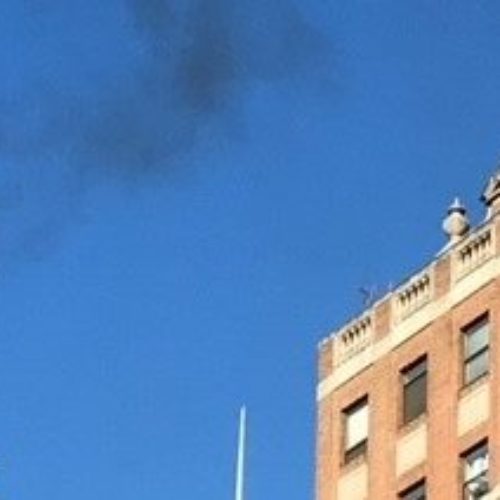States turn to nature-based solutions to address the climate challenge
This article appears in the 2020-2021 edition of CSG East’s Perspectives Magazine.

Research shows that sequestration could provide one-third of the cost-effective emissions reductions needed to keep the global rise in temperature below 2 degrees Celsius, in line with the goal of the Paris Agreement. Photo courtesy of Felix Mittermeier.
In late December 2019, a group of officials from five northeastern states met in Hudson, New York, to consider ways to enlist nature in the fight against climate change.
On a large screen, they viewed images of growers practicing no-till farming and using cover crops, methods that keep carbon in the ground while making soils healthier and more resilient to flooding, drought, and erosion — and also help a farmer’s bottom line.
Dr. Sara Via, a professor at the University of Maryland who is an expert in soil carbon sequestration, explained that Maryland farmers have been sequestering carbon for years through agricultural practices used because they improve water quality. Until recently, however, no one thought to measure how much of the carbon captured by plants from the sun was being stored in the soil.
When they did, the results were promising. Via’s research suggests that in Maryland, these practices have captured several million tons of carbon while also saving farmers millions in energy and labor costs. Increasing their use could store far more carbon in future years, said Via.
“Land-based carbon sequestration has proven to be an effective way to remove carbon dioxide from the atmosphere. It’s practical, and low cost, and we can do it right now,” said Via.
The discussion, organized by the CSG East Energy and Environment Committee, carried a sense of urgency. Research shows that the global community is not reducing carbon pollution fast enough to avoid dangerous warming and that enhancing the ability of trees, soils, crops, and other “natural solutions” to suck carbon dioxide out of the air will be essential to avoiding the worst impacts from climate change. The officials were hoping to catalyze those practices on a regional scale.
Healthy soils
The meeting launched an informal working group that met virtually more than a dozen times over the course of 2020 with representatives of state agencies, academia, and nonprofits. Members learned from experts who are working to develop better methods to quantify how much carbon is stored through different farming and forestry management practices, and devising creative financing tools to incentivize their use.
Since the beginning of the industrial revolution, humans have pumped around 2,000 gigatons of carbon dioxide into the atmosphere, largely from the burning of fossil fuels. Climate scientists warn that even if the global community were to cease to emit carbon today and transition entirely to emission-free renewable forms of energy, that “legacy” carbon would still be there, warming the atmosphere for decades or more.
Taking carbon out of the air by harnessing nature’s vast ability to store it in soil, trees, and crops could hold the key to “drawing down” greenhouse gases from the atmosphere and doing it in an affordable way. A 2017 report published in the Proceedings of the National Academies of Sciences found that sequestration could provide one-third of the cost-effective emissions reductions needed to keep the global rise in temperature below 2 degrees Celsius, in line with the goal of the Paris Agreement.
Soil experts say a critical step forward involves reversing tilling and other industrial farming practices that destroy topsoil by depleting it of important microbes, bacteria, fungi, and other organic matter that keeps carbon in the ground. From the late 1880s to 1985, agricultural soils have lost at least half of the organic carbon that was present before industrialization, said Jennifer Moore-Kucera, climate initiative director at American Farmland Trust, in testimony before the U.S. House Select Committee on the Climate Crisis in October 2019. About a third of the carbon in the atmosphere has been linked to the clearing of forests and the cultivation of land to produce food, she added.
“If we want to achieve drawdown, we have to start to farm and grow our plants and trees in an entirely different way,” said author and environmentalist Paul Hawken in the 2020 documentary Kiss the Ground. “The very practices that heal our soils will also heal our climate.”
Via said her own research revealed that from 2006 to 2018, Maryland farmers sequestered 6 million metric tonnes of carbon in the soil, which is equivalent to taking 1.3 million cars off the road. The reduction was roughly equal to the avoided emissions over the same time period from the state’s participation in the Regional Greenhouse Gas Initiative, the 10-state cap-and-trade program to reduce carbon pollution from large power plants in the Northeast.
The farmers stored carbon through no-till farming, in which cropland is used for production without disturbing the soil through tillage. Soil that isn’t tilled protects carbon from loss, increases microbial growth, and leads to more plant growth. They also planted cover crops, which also help store carbon while increasing soil health and reducing erosion.
Maryland has found particular value in cover cropping, which reduces agricultural runoff and is central to the state’s strategy to restore the Chesapeake Bay. Since the early 1990s, Maryland has been paying farmers to plant cover crops, and today, nearly half of the state’s farmland uses them, compared to less than 4 percent nationwide.
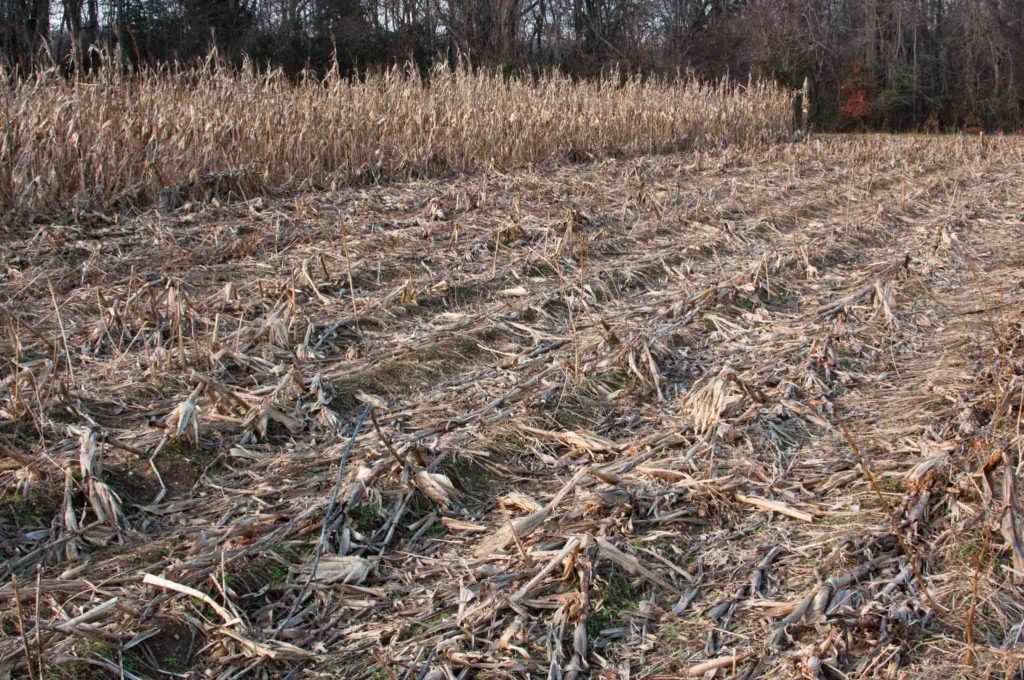
Crop residue from no-till agriculture at Merkle Wildlife Sanctuary in Upper Marlboro, Maryland.
Credit: Alicia Pimental/Chesapeake Bay Program (CC BY-NC 2.0)
Green financing
But paying farmers and forest landowners specifically to remove carbon from the air is still a recent concept.
Globally, a mere 3 percent of total financing for climate mitigation is directed to nature-based solutions. During the United Nations Climate Action summit in 2019, a coalition of nations led by China and New Zealand released a “manifesto” calling for bold action to scale up investments in the sector. “World leaders should do all within their power to ensure that nature’s transformative potential is fully valued and realized in decision-making especially in relation to climate action,” the document says.
A growing list of companies, including Shell and Amazon, have announced major investments in nature-based offsets to meet internal carbon reduction goals and showcase their green credentials. Earlier this year, Microsoft announced it would devote $1 billion to speeding the development of carbon capture technologies.
In the United States, a consortium of food giants, producers, and nongovernmental organizations has raised $20 million to launch a voluntary marketplace for carbon and water quality credits generated by farmers and ranchers in the Midwest and western United States by 2022. The CSG East working group learned about projects being developed in the Northeast to generate carbon offsets for urban forestry projects, and about others targeting small rural landowners, who would earn income from offsets in exchange for implementing sustainable forest practices that help sequester and store more carbon.
The working group explored innovative financing mechanisms that could facilitate such programs, including the use of state revolving funds to provide credit enhancement for sequestration projects and help project developers access private capital. Members met with officials from the Connecticut Green Bank to learn about its first-in-the-nation green liberty bonds, which are enabling individuals to invest in clean-energy projects, and discussed the potential to apply them to sequestration projects.
Maryland state Delegate Dana Stein said these virtual conversations have helped inform legislation that he plans to introduce next session calling for the state to plant 5 million trees beyond its current tree-planting goals over 10 years. The bill also calls for a 60 percent cut in economywide carbon emissions by 2030, up from the current 40 percent target, and it would compel the state to achieve net-zero emissions by 2045.
“CSG has been instrumental in connecting me with potential funders of sequestration efforts,” said Stein, who is vice chair of the House Environment and Transportation Committee. “Thanks to the virtual meetings organized by CSG’s Eastern Region, I am now confident that the 5 million tree initiative I’ll be sponsoring next year in Maryland will include nongovernmental funding.”
Quantifying the benefits
Stein has been a champion of natural climate solutions in Maryland. Legislation that he sponsored in 2017 led to the creation of the state’s Healthy Soils Program, which provides research, education, technical assistance, and financial incentives to farmers who implement practices to increase organic matter, improve the soil’s ability to hold water and nutrients, and sequester carbon.
Via said that these advances in Maryland will be amplified with additional research on carbon sequestration, since different soils can store varying amounts of carbon due to climatic conditions, management practices, and other factors. Although changes in carbon storage over just a year or two can be hard to detect directly in a particular field, researchers have developed sophisticated ways to combine long-term data with computer modeling of local conditions to accurately determine the amount of greenhouse gas reduction attributable to agricultural practices at a statewide level.
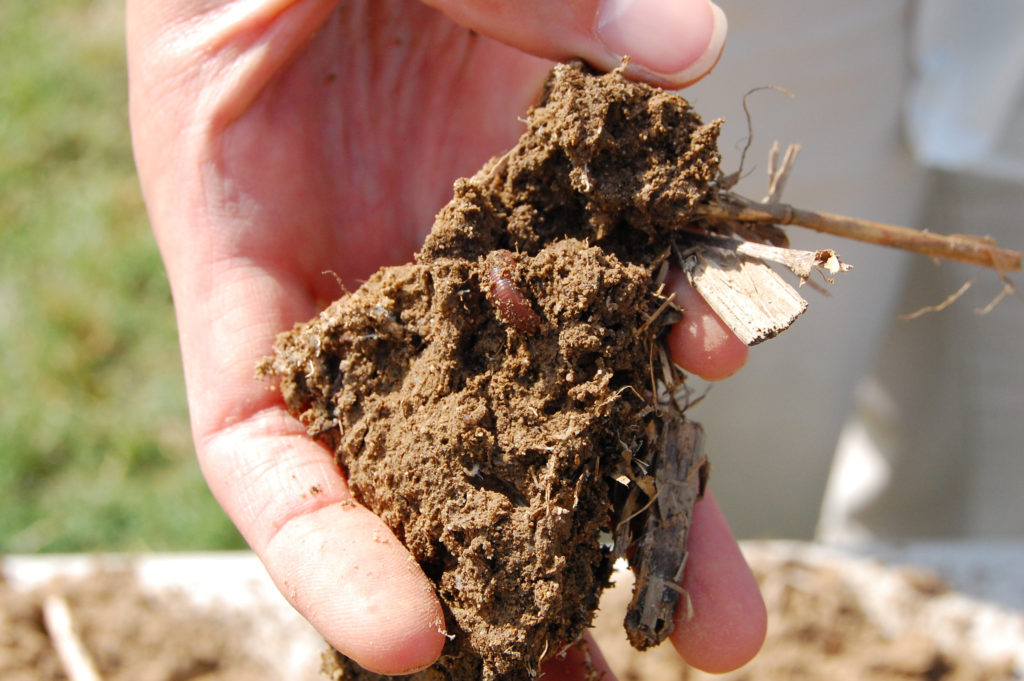
A sample of healthy soil.
Credit: Alicia Pimental/Chesapeake Bay Program (CC BY-NC 2.0)
Compiling better data is also essential to maximizing carbon storage in forests, which is where the lion’s share of carbon sequestration is occurring. Forests account for 90 percent of land-sector sequestration in the United States, and they offset nearly 15 percent of total U.S. carbon emissions, according to the nonprofit American Forests.
A federal analysis released during the Barack Obama administration calculated that sequestration could offset up to 45 percent of economywide emissions in 2050, with U.S. forests playing a central role. The increase would require expanding forests by 40–50 million acres over the next 20–35 years — equivalent to recovering one-third of U.S. forestland that has been lost since the industrial revolution.
During a virtual discussion with Maryland environmental agency staff, the CSG East working group learned how the state is using high-resolution lidar mapping of the state’s forest biomass to obtain more accurate data on its sequestration potential. The data will be combined with satellite imagery showing how much forest the state is gaining or losing on an annual basis and how much carbon is associated with those changes. That information will be integrated into the state’s 2030 climate plan, which calls for projects including enhanced forest management, tree planting, and wetland restoration on state and private lands. The state had previously relied on less-precise federal data, some of which was out of date and did not provide site-specific information, such as changes in land use.
The project’s methodology will be made available to other northeastern states that are exploring ways to maximize nature-based solutions. New Jersey and Maine have identified sequestration in forests, agricultural lands, and potentially “blue carbon” — coastal ecosystems such as tidal salt marshes and seaweed habitats — as pivotal to their efforts to slash economywide emissions at least 80 percent by midcentury. In New York, a 2019 state law mandates carbon neutrality by 2050, with 15 percent of emissions reductions coming from carbon offsets including sequestration.
“We know that in order to do this, the agricultural sector is going to have to reduce its greenhouse footprint and increase sequestration efforts,” said New York Agriculture Commissioner Richard Ball during a press event on November 12 announcing the launch of a two-year “carbon farming” pilot.
The pilot will test agricultural practices that mitigate carbon emissions and store carbon in soil that is specific to the Hudson Valley, which is dominated by diverse small farms, including vineyards, orchards, and vegetable and livestock producers. Twenty-two farms are participating across five upstate counties.
Until now, most of the existing data on carbon-friendly practices have been generated from large-scale farms in other regions that primarily grow row crops, said Brian Scoralick, executive director of the Dutchess County Soil and Water District, which is leading the pilot.
“Here in the Hudson Valley, we don’t have a lot of those large-scale acreage row crop systems,” said Scoralick during the press event. “The intent is to get the soil’s baseline data, do some implementation, and then do periodic soil tests and follow up over two years. We’re trying to come up with some measurable numbers.”

New York state Assemblymember Didi Barrett.
The pilot was created following the passage of a 2018 bill sponsored by state Assemblymember Didi Barrett, who was an early champion of farming methods that lock carbon in plants and soils and promote soil health. The coronavirus pandemic delayed the launch of the pilot, which had been slated to begin last spring.
“Our journey to increase carbon farming practices in New York state and throughout the Northeast and Mid-Atlantic regions has been slow, but rewarding,” said Barrett. “The work we have done through CSG has moved the conversation forward, underlining the important interface of climate control and agriculture.”

